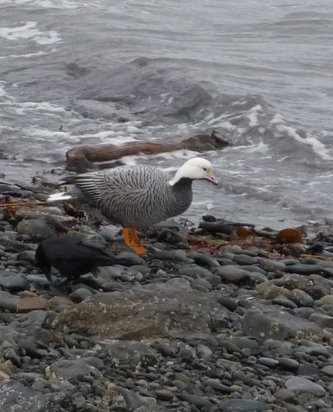Oh sure, it’s easy to count and identify birds during the balmy spring days of the Kachemak Bay Shorebird Festival. In winter, when Homer only gets six hours of daylight, temperatures drop into single digits and it could be blowing snow sideways, that’s when the tough birders come out.
Since 1973, though, dedicated birders have shown up on a December Saturday to join the National Audubon Society’s annual Christmas Bird Count. This year, the bird count happens Saturday starting at 8:30 a.m. Birders meet at the Alaska Islands and Ocean Visitor Center to organize into teams, and then fan out in a 15-mile wide circle centered at the base of the Homer Spit to see how many species and birds they can count in one day. The day ends about 4 p.m. back at Islands and Ocean to review sightings and warm up with a community potluck.
New to birding or unsure about your identification skills? Novice birders can team with experienced birders. It’s also a good all-ages family event. At 6:30 p.m. today, birder Dave Erikson, who has led the bird count for more than 35 years, teaches a winter bird identification class in the seminar room of Islands and Ocean.
Now in its 114th year as a national program, the Audubon Christmas Bird Count is the longest-running citizen science activity in the United States. Counts also are done in Canada and some of the Caribbean Sea islands.
The bird count began as a reaction to a 19th century holiday tradition, the side hunt, where teams of hunters competed to take the largest number of birds. For Christmas Day 1900, ornithologist Frank Chapman, an early Audubon Society officer, proposed a bird census — counting and not killing birds.
As a result, the Christmas Bird Count has created a good information set that shows changes in bird species over time. That’s the idea of the count, said Erikson.
“The purpose of the count is to document what is here over a long period of time on one particular day,” he said.
In Homer, the count has shown some interesting changes, like that of the northwestern crow. Over the decades the numbers of crows on the north shore of Kachemak Bay have increased dramatically, Erikson said.
“Back in the 1970s we had just a handful of them out on the Spit eating mussels,” he said.
Crows were once so uncommon in Homer that old timers called them “Seldovia crows,” because that’s where they were more likely to be seen, Erikson said. Crows have now become adept at scavenging food from Dumpsters, garbage cans and food or trash bags in the beds of pickup trucks — a skill that parent crows teach their young. Homer also has more mountain ash trees and berries, another food source. Now, bird counts are close to 1,000.
Warmer winters and the planting of more ornamental trees also has led to an increase in what some see as a harbinger of spring — the American robin. Forty years ago, if any robin tried to stay, it didn’t make it, Erikson said.
“Now, they’re able to overwinter here in much larger numbers,” he said. “We’ll get flocks of 200 robins.”
Alarming trends have been the declines in some species. Steller’s eider, a mallard size duck that’s white with black stripes for the male, used to be in Homer in large flocks but has declined in numbers. It’s now considered a threatened species, Erikson said.
While numbers of one species of bird can be interesting, it’s the total number of species that birders look for.
“We don’t concentrate a lot on numbers per se,” Erikson said. “Total numbers vary quite a bit depending on the weather.”
For example, if Mud Bay freezes up, ducks like mallards will move to the south side of the bay. If Mud Bay opens up, mallards will come here, along with widgeons — previously a rarity for the Christmas Bird Count.
Also interesting will be wayward birds. Some species that summer in the north go the wrong direction when heading south for the winter.
“They’re just out of their ranges. They’re trying to winter in the wrong location,” Erikson said. “Those are always fun to see. They’re oddities.”
Such birds include the Asian gull and the slaty-backed gull.
“That’s just on the wrong side of the Pacific,” Erikson said.
Other unusual birds already seen include the Anna’s hummingbird and a left-behind sandhill crane heard in Hidden Hills near the North Fork Road.
The fun of the count is to see how many species can be seen as well as unusual species. A possible 90 species can be seen that might be here in December, but the average number is 62. That’s where many people looking can increase counts.
“You get that many eyes out on a particular day, it’s amazing what you can come up with,” Erikson said.
Birds also can be counted at backyard feeders before and after the count day, from Dec. 11-13 and Dec. 15-17.
Michael Armstrong can be reached at
michael.armstrong@homernews.com.
Winter Bird Identification Class
6:30 p.m. Thursday
Seminar Room,
Alaska Islands and Ocean Visitor Center
Learn how to identify winter birds with Dave Erikson.
Homer Christmas Bird Count
8:30 a.m.-4:30 p.m. Saturday
4 p.m. Potluck
Meet at Alaska Islands and Ocean Visitor Center.
Sponsored by the Kachemak Bay Birders and the Alaska Maritime National Wildlife Refuge.
Bring binoculars, spotting scopes, birding guides and dress warmly for the weather. Birders of all abilities welcome. Novice birders will be paired with experienced birders.
What: In Homer, count birds and species in a 15-mile diameter count area centered on the Homer Spit.
Why: To monitor and track changes in bird species and numbers throughout the United States.
Average number of species counted: 62.
Possible number of species that can be seen: about 90.
For more information, call Dave Erikson, 235-3487, email derikson@alaska.net; B.J. Hitchcock, 235-1265, hitchcock613@msn.com; Lani Raymond, 399-9477, lani67@gmail.com


